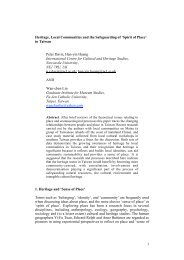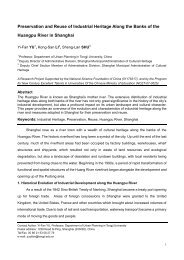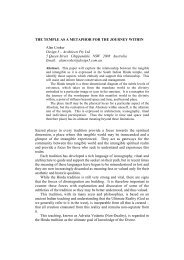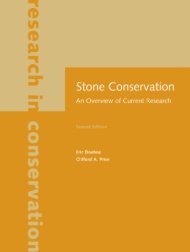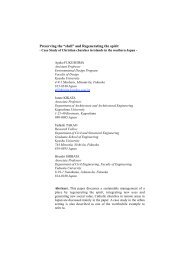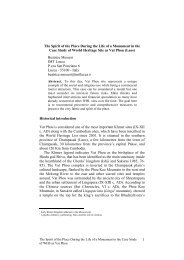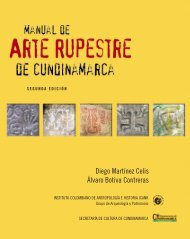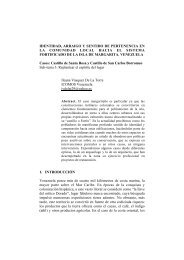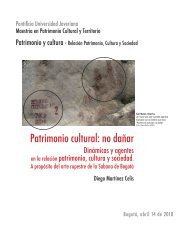Rendre compatible les techniques traditionnelles et les modernes ...
Rendre compatible les techniques traditionnelles et les modernes ...
Rendre compatible les techniques traditionnelles et les modernes ...
- No tags were found...
Create successful ePaper yourself
Turn your PDF publications into a flip-book with our unique Google optimized e-Paper software.
<strong>Rendre</strong> <strong>compatible</strong> <strong>les</strong> <strong>techniques</strong> traditionnel<strong>les</strong> <strong>et</strong> <strong>les</strong> <strong>modernes</strong>Compatibilizar técnicas tradiciona<strong>les</strong> y modernasCombining traditional and modern <strong>techniques</strong>of mortar loss, material loss of stones occurs.1.2.4. Plaster ProblemsThe plaster problems are classified into four categories; “loss of plaster”,“d<strong>et</strong>achment from wall surface”, “salt deposition” and “discoloration”. Likestone the worst problems are areas under eaves, lower levels of frontalwalls, and corners of the jambs due to dampness. Soiling and crusts arealso seen deposited on plasters.Loss of plaster is the first stage of increasing decays on building façades.Where plaster is d<strong>et</strong>ached, stone and mortar are prone to problems.As plaster is the protective layer, the maintenance of plaster is veryimportant. As the stones of these buildings are closer to cut-stone, theydo not l<strong>et</strong> exterior partic<strong>les</strong>, salts and humidity in as much as the roughcut stones.1.2.5. M<strong>et</strong>al ProblemsThe m<strong>et</strong>al elements are iron in all of the traditional buildings. Problemsof m<strong>et</strong>als do not show much vari<strong>et</strong>y. Oxidation, inspected especially onshutter hinges, and supports is the main problem. Almost all unpaintediron elements, like doors and shutters, are oxidized.2.Proposals for Repairs of the Studied BuildingsAs a result of the studies on building materials, and repair problems,guidelines are formed for different types of repairs that are widelyneeded in the studied buildings. Proposals for these repairs andmaintenance are prepared to be used as guidelines for users and aconservation program.2.1. Cure of Rising DampThere are two sources of water causing rising damp: rainfall andunderground water. The comprehensive m<strong>et</strong>hod of overcoming theexcess water is a b<strong>et</strong>ter drainage system. ventilation, rather than a monolithic one having cement mortar asbinder”, and bottom in front of the base of the damp buildings to reduce thecapillary action”.2.2. Masonry RepairsDuring the repair of masonry, a minimum of stone replacement mustbe done. The new stones are often more difficult to maintain than theold stones. Repair work to be done to these masonry buildings is gapfilling rather than consolidating. Only the buildings, which lost plasterand mortar in joints, started to have small loss and d<strong>et</strong>achment of stoneproblems. There emerged small gaps and cracks, which may weakenthese stones. The stones with special craftsmanship such as inscriptions,panels, keystones, jambs, architraves and some of the eaves needs gapfilling or consolidation work.“Using <strong>compatible</strong> mortars with stones”, and “taking care of esth<strong>et</strong>icalharmony b<strong>et</strong>ween mortars and stones” must be considered while gapfilling.2.3. Grouting and Re-pointingGrouting seems to be a appropriate m<strong>et</strong>hod for some of the buildings,which have compl<strong>et</strong>ely emptied joints and probably have voidsb<strong>et</strong>ween the layers. Similar building types have collapsed and provedthe severity of the problem. Although grouting is not widespread inTurkey, it is the best m<strong>et</strong>hod for consolidating these buildings.Grouting Masonry Walls: The consolidation of historic masonry involvesthe need to stabilise walls by filling voids within their thickness. Thisoperation is most commonly needed when thick walls of doub<strong>les</strong>kin construction, with rubble core filling, have been subject tothe percolation of water for many years. The important point inconsolidating the masonry with a liquid binder is to select a binder thatis <strong>compatible</strong> with stone and former mortar.Re-pointing.: Re-pointing should be carried out immediately to preventthe rapid weathering of the stones. When the mortar in the joints isweathered, the stones become vulnerable to damage and material losson stone surfaces are seen.Permeability, porosity, density and other properties of mortar and stonemust be recorded. When the mortar is <strong>les</strong>s permeable and <strong>les</strong>s porousthan stone, it acts like a vapour barrier in the wall, causes a continuousvapour flow into the stone and prevents evaporation. A permanentdampness can occur in stone that is very harmful. Cement basedmortars in contact with stone can introduce sodium or potassiumsulphate (3) and must be avoided, not only in the preparation of mortarbut also in every stage of repairs.Re-pointing is an advanced type of work, and must be done byqualified workers. Flush filling will greatly increase the apparent widthof the joint, and therefore great care must be taken to keep the layer ofthe new mortar within the original width. mortar.2.4. Plastering and PaintingPlastering: After grouting and re-pointing, plastering the external wallsis necessary. All of the buildings in the area need plaster repairs, exceptthe ones that have never been plastered. The properties of plaster mustbe <strong>compatible</strong> with former plaster and stone. If the plaster is moreporous than stone it weakens quickly and if it is <strong>les</strong>s porous it causes thed<strong>et</strong>erioration of stone by transporting salts and vapour. The criteria forinterior and exterior plasters do not change, while their composition isdifferent due to the different conditions in and outside the buildings.Painting: Painting is the last step of the maintenance of the walls.Besides the compatibility of properties of paint with the plasters andstones, colours have to be carefully selected for the harmony with theother paints in the district. Some of the plasters in the site are colouredwith original colours extracted from plants and earth (indigo, madder,i.e.)2.5. Timber Repair and ConsolidationStructural timber elements like floors and roofs more urgently needattention and must be solved immediately. The main works to be donefor the maintenance of the timbers are;Local or Total Replacements of Timber Elements with New Timber:545



